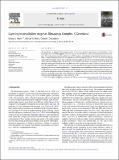Files in this item
Layering in peralkaline magmas, Ilímaussaq Complex, S Greenland
Item metadata
| dc.contributor.author | Hunt, Emma J. | |
| dc.contributor.author | Finch, Adrian A. | |
| dc.contributor.author | Donaldson, Colin H. | |
| dc.date.accessioned | 2016-11-14T11:30:16Z | |
| dc.date.available | 2016-11-14T11:30:16Z | |
| dc.date.issued | 2017-01 | |
| dc.identifier | 247263599 | |
| dc.identifier | f59e3d75-2fe8-4928-b800-26bd924c28e3 | |
| dc.identifier | 84996573009 | |
| dc.identifier | 000392680400001 | |
| dc.identifier.citation | Hunt , E J , Finch , A A & Donaldson , C H 2017 , ' Layering in peralkaline magmas, Ilímaussaq Complex, S Greenland ' , Lithos , vol. 268-271 , pp. 1-15 . https://doi.org/10.1016/j.lithos.2016.10.023 | en |
| dc.identifier.issn | 0024-4937 | |
| dc.identifier.other | RIS: urn:EBF8D2270912682BDEFB38FA610C5E39 | |
| dc.identifier.other | ORCID: /0000-0002-3689-1517/work/38002300 | |
| dc.identifier.uri | https://hdl.handle.net/10023/9817 | |
| dc.description | EJH acknowledges funding from a NERC PhD studentship and the work was completed at the University of St Andrews, UK. | en |
| dc.description.abstract | The peralkaline to agpaitic Ilímaussaq Complex, S. Greenland, displays spectacular macrorhythmic (> 5 m) layering via the kakortokite (agpaitic nepheline syenite), which outcrops as the lowest exposed rocks in the complex. This study applies crystal size distribution (CSD) analyses and eudialyte-group mineral chemical compositions to study the marker horizon, Unit 0, and the contact to the underlying Unit − 1. Unit 0 is the best-developed unit in the kakortokites and as such is ideal for gaining insight into processes of crystal formation and growth within the layered kakortokite. The findings are consistent with a model whereby the bulk of the black and red layers developed through in situ crystallisation at the crystal mush–magma interface, whereas the white layer developed through a range of processes operating throughout the magma chamber, including density segregation (gravitational settling and flotation). Primary textures were modified through late-stage textural coarsening via grain overgrowth. An open-system model is proposed, where varying concentrations of halogens, in combination with undercooling, controlled crystal nucleation and growth to form Unit 0. Our observations suggest that the model is applicable more widely to the layering throughout the kakortokite series and potentially other layered peralkaline/agpaitic rocks around the world. | |
| dc.format.extent | 15 | |
| dc.format.extent | 15343511 | |
| dc.language.iso | eng | |
| dc.relation.ispartof | Lithos | en |
| dc.subject | Ilímaussaq Complex | en |
| dc.subject | Kakortokite | en |
| dc.subject | Agpaitic | en |
| dc.subject | Macrorhythmic layering | en |
| dc.subject | Crystal size distribution | en |
| dc.subject | Eudialyte-group minerals | en |
| dc.subject | GE Environmental Sciences | en |
| dc.subject | DAS | en |
| dc.subject | BDC | en |
| dc.subject.lcc | GE | en |
| dc.title | Layering in peralkaline magmas, Ilímaussaq Complex, S Greenland | en |
| dc.type | Journal article | en |
| dc.contributor.institution | University of St Andrews. Earth and Environmental Sciences | en |
| dc.contributor.institution | University of St Andrews. School of Earth & Environmental Sciences | en |
| dc.contributor.institution | University of St Andrews. Scottish Oceans Institute | en |
| dc.contributor.institution | University of St Andrews. St Andrews Isotope Geochemistry | en |
| dc.contributor.institution | University of St Andrews. Marine Alliance for Science & Technology Scotland | en |
| dc.identifier.doi | 10.1016/j.lithos.2016.10.023 | |
| dc.description.status | Peer reviewed | en |
This item appears in the following Collection(s)
Items in the St Andrews Research Repository are protected by copyright, with all rights reserved, unless otherwise indicated.

